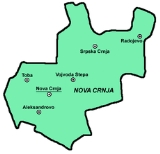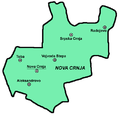
Srpska Crnja
Encyclopedia

Serbia
Serbia , officially the Republic of Serbia , is a landlocked country located at the crossroads of Central and Southeast Europe, covering the southern part of the Carpathian basin and the central part of the Balkans...
, situated in central-east Banat
Banat
The Banat is a geographical and historical region in Central Europe currently divided between three countries: the eastern part lies in western Romania , the western part in northeastern Serbia , and a small...
alongside the border with Romania
Romania
Romania is a country located at the crossroads of Central and Southeastern Europe, on the Lower Danube, within and outside the Carpathian arch, bordering on the Black Sea...
. It is located in Nova Crnja
Nova Crnja
Nova Crnja is a village and municipality in Central Banat District of Vojvodina, Serbia. The village has a population of 1,858, while Nova Crnja municipality has 12,661 inhabitants.-Inhabited places:Nova Crnja municipality includes the following villages:...
municipality, Central Banat District
Central Banat District
Central Banat District is a northeastern district of Serbia. It lies in the region of Banat, in the autonomous province of Vojvodina. It has a population of 208,456...
, Province of Vojvodina
Vojvodina
Vojvodina, officially called Autonomous Province of Vojvodina is an autonomous province of Serbia. Its capital and largest city is Novi Sad...
. It is about 150 km away from the capital city of Belgrade
Belgrade
Belgrade is the capital and largest city of Serbia. It is located at the confluence of the Sava and Danube rivers, where the Pannonian Plain meets the Balkans. According to official results of Census 2011, the city has a population of 1,639,121. It is one of the 15 largest cities in Europe...
, 113 km from Novi Sad
Novi Sad
Novi Sad is the capital of the northern Serbian province of Vojvodina, and the administrative centre of the South Bačka District. The city is located in the southern part of Pannonian Plain on the Danube river....
, 9 km south-east of Kikinda
Kikinda
Kikinda is a town and a municipality located in Serbia, in the autonomous province of Vojvodina. It is the administrative centre of the North Banat District. The town has 42,000 inhabitants, while the municipality has approximately 67,000 inhabitants.The modern city was founded in 18th century...
and 6 km south-west of Jimbolia
Jimbolia
Jimbolia is a town in Timiş county, Romania. In 2004, it had a population of 11,605.-History:The earliest record of a community in this location is a place identified as Chumbul in a papal tax record in 1333. This place came under Turkish administration in 1552. As a result of the Treaty of...
, Romania
Romania
Romania is a country located at the crossroads of Central and Southeastern Europe, on the Lower Danube, within and outside the Carpathian arch, bordering on the Black Sea...
. The town has a population of 4,383 people (2002 census) and most of its inhabitants are ethnic Serbs
Serbs
The Serbs are a South Slavic ethnic group of the Balkans and southern Central Europe. Serbs are located mainly in Serbia, Montenegro and Bosnia and Herzegovina, and form a sizable minority in Croatia, the Republic of Macedonia and Slovenia. Likewise, Serbs are an officially recognized minority in...
.
History
Srpska Crnja is a very old settlement. The first historical records mentioning the town are from 1373, and the first time it appeared on a map was in 1723. The famous poet and artist Đura Jakšić was born and grew up in the town. Srpska Crnja has been also referred to as Deutsch-Zerne prior to 1944, referring to the western part of town where the population consisted mostly of ethnic Germans. Crnja, basically existed for two centuries as a twin-town—Srpska Crnja + Deutsch-Zerne (also known as Deutsch-Tschernja)It is important to point out a number of other historical facts about the history of Deutsch-Zerne and Srpska Crnja, namely:
Under Austrian Empress Maria Theresia, and after Prince Eugene of Savoy expelled the Turks out of Serbia and Belgrade, the Banat region became a Crownland of Austria. Ethnic Germans, who founded Deutsch-Zerne (which adjoined Srpska Crnja) immigrated to the region in 1782. Eventually the German paopulation of Deutsch-Zerne increased and by 1944 had reached over 3,000 people.
In the aftermath of the second World War, and after Partisans gained control of the area in October 1944, a large number of the German-speaking male population were brutally murdered and buried in mass graves in the former Roma area outside Deutsch-Zerne. This fact is documented in several books and publications and readily available in most public libraries worldwide.
Likewise woman between the ages 20 and 35 were rounded up and sent to forced labor camps in Siberia. Once again this is a well-documented, and survivors exist to document this fact of history.
The rest of the ethnic Germans, mostly older women and young children, were send to labor camps in Molidorf, Gackovo, etc. where hundreds died due to malnutrition and sickness. The remaining were eventually became refugees and settled in Austria, Germany, or emigrated to the U.S.A and Australia.
Today Crnja's ethnic makeup is essentially 85% Serbian, and 105 Roma and no historic pointer aside from the Catholic church, the cemetery and most of the towns original buildings. The former railroad link to other towns is no longer in existence. Very little reminds visitors today that this was once a growing, healthy, and productive agricultural town and region (i.e known as the "foodbasket of Europe") supplying and exporting products to the rest of Europe.
As a result of the current dismal economic situation in the Banat region, a good number of Serbs are now going to Austria and Germany to find jobs. We consider that a great irony of history.
Ethnic groups (2002 census)
- SerbsSerbsThe Serbs are a South Slavic ethnic group of the Balkans and southern Central Europe. Serbs are located mainly in Serbia, Montenegro and Bosnia and Herzegovina, and form a sizable minority in Croatia, the Republic of Macedonia and Slovenia. Likewise, Serbs are an officially recognized minority in...
= 3,672 (83.78%) - Roma = 413 (9.42%)
- Hungarians = 163 (3.72%)
- others.
Sights
- Orthodox churchSerbian Orthodox ChurchThe Serbian Orthodox Church is one of the autocephalous Orthodox Christian churches, ranking sixth in order of seniority after Constantinople, Alexandria, Antioch, Jerusalem, and Russia...
built in 1775, with Đura Jakšić's religious paintings (icons) on the altar. - Memorial museum of Đura Jakšić.
- Bust of Đura Jakšić located in the nave of the Orthodox church.
- Monument to people of Srpska Crnja who were killed on October 5 - Freedom Day in memory of the liberation from German occupation 1944, also located in the nave of the Orthodox church.
- The oldest grave monument, from 1790.
- The Lipar's Days in Srpska Crnja is a manifestation dedicated to Crnja's beloved Đura Jakšić. The tradition started in 1962.
- Motel Kastel built as a castle 1943 for general Najhauzen during the Nazi German occupation.
See also
- List of places in Serbia
- List of cities, towns and villages in Vojvodina
- Nova CrnjaNova CrnjaNova Crnja is a village and municipality in Central Banat District of Vojvodina, Serbia. The village has a population of 1,858, while Nova Crnja municipality has 12,661 inhabitants.-Inhabited places:Nova Crnja municipality includes the following villages:...

